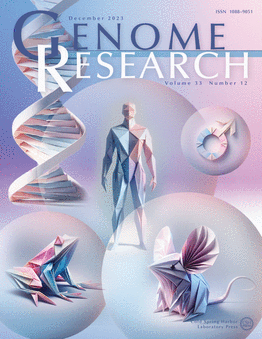Genetic regulation of nascent RNA maturation revealed by direct RNA nanopore sequencing
IF 6.2
2区 生物学
Q1 BIOCHEMISTRY & MOLECULAR BIOLOGY
引用次数: 0
Abstract
Quantitative trait loci analyses have revealed an important role for genetic variants in regulating alternative splicing (AS) and alternative cleavage and polyadenylation (APA) in humans. Yet, these studies are generally performed with mature mRNA, so they report on the outcome rather than the processes of RNA maturation and thus may overlook how variants directly modulate pre-mRNA processing. The order in which the many introns of a human gene are removed can substantially influence AS, while nascent RNA polyadenylation can affect RNA stability and decay. However, how splicing order and poly(A) tail length are regulated by genetic variation has never been explored. Here, we used direct RNA nanopore sequencing to investigate allele-specific pre-mRNA maturation in 12 human lymphoblastoid cell lines. We find frequent splicing order differences between alleles and uncover significant single-nucleotide polymorphism (SNP)-splicing order associations in 17 genes. This includes SNPs located in or near splice sites as well as more distal intronic and exonic SNPs. Moreover, several genes showed allele-specific poly(A) tail lengths, many of which also have a skewed allelic abundance ratio. HLA class I transcripts, which encode proteins that play an essential role in antigen presentation, show the most allele-specific splicing orders, which frequently co-occur with allele-specific AS, APA, or poly(A) tail length differences. Together, our results expose new layers of genetic regulation of pre-mRNA maturation and highlight the power of long-read RNA sequencing for allele-specific analyses.求助全文
约1分钟内获得全文
求助全文
来源期刊

Genome research
生物-生化与分子生物学
CiteScore
12.40
自引率
1.40%
发文量
140
审稿时长
6 months
期刊介绍:
Launched in 1995, Genome Research is an international, continuously published, peer-reviewed journal that focuses on research that provides novel insights into the genome biology of all organisms, including advances in genomic medicine.
Among the topics considered by the journal are genome structure and function, comparative genomics, molecular evolution, genome-scale quantitative and population genetics, proteomics, epigenomics, and systems biology. The journal also features exciting gene discoveries and reports of cutting-edge computational biology and high-throughput methodologies.
New data in these areas are published as research papers, or methods and resource reports that provide novel information on technologies or tools that will be of interest to a broad readership. Complete data sets are presented electronically on the journal''s web site where appropriate. The journal also provides Reviews, Perspectives, and Insight/Outlook articles, which present commentary on the latest advances published both here and elsewhere, placing such progress in its broader biological context.
 求助内容:
求助内容: 应助结果提醒方式:
应助结果提醒方式:


